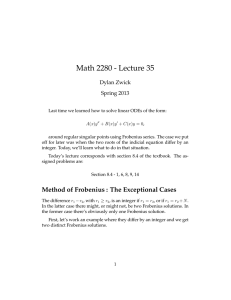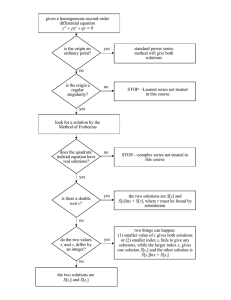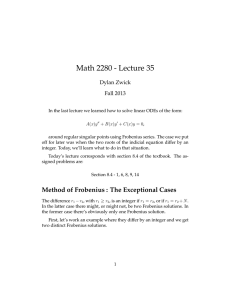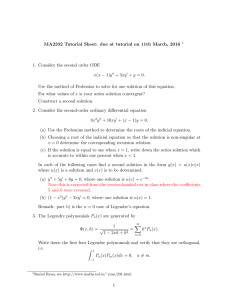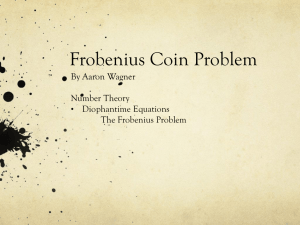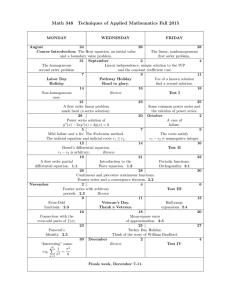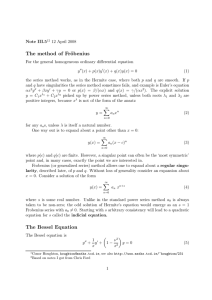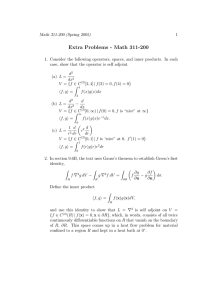Math 2280 - Lecture 35 Dylan Zwick Fall 2013
advertisement
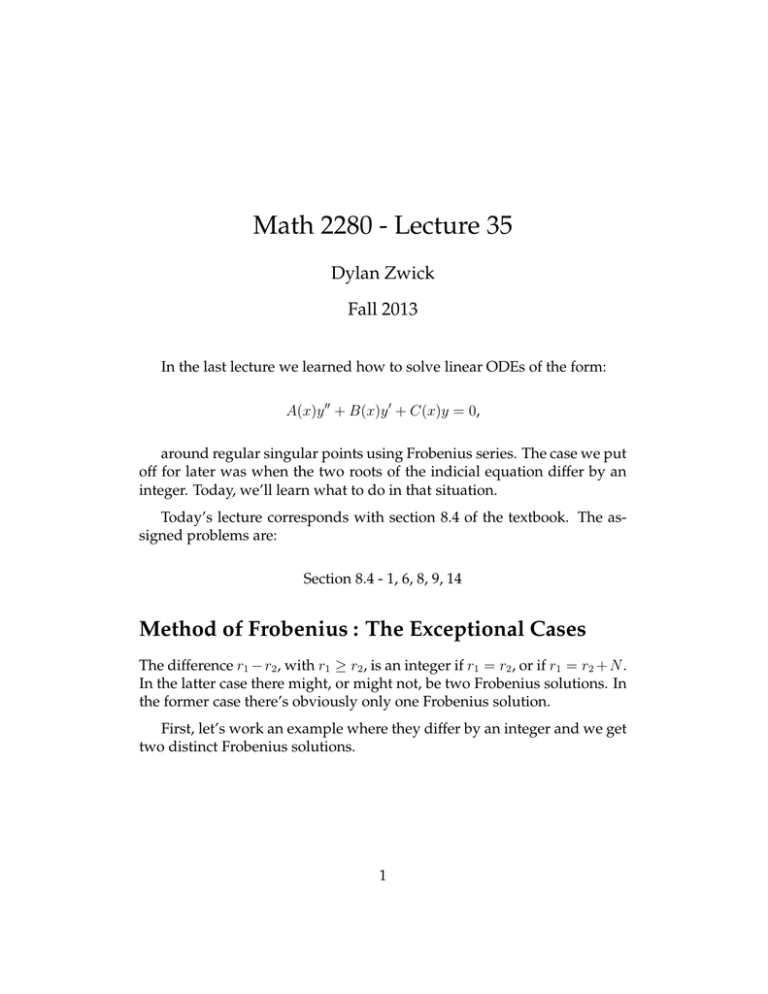
Math 2280 - Lecture 35 Dylan Zwick Fall 2013 In the last lecture we learned how to solve linear ODEs of the form: A(x)y ′′ + B(x)y ′ + C(x)y = 0, around regular singular points using Frobenius series. The case we put off for later was when the two roots of the indicial equation differ by an integer. Today, we’ll learn what to do in that situation. Today’s lecture corresponds with section 8.4 of the textbook. The assigned problems are: Section 8.4 - 1, 6, 8, 9, 14 Method of Frobenius : The Exceptional Cases The difference r1 − r2 , with r1 ≥ r2 , is an integer if r1 = r2 , or if r1 = r2 + N. In the latter case there might, or might not, be two Frobenius solutions. In the former case there’s obviously only one Frobenius solution. First, let’s work an example where they differ by an integer and we get two distinct Frobenius solutions. 1 Example - Solve the ODE: x2 y ′′ + (6x + x2 )y ′ + xy = 0. Solution - Here p0 = 6 and q0 = 0, and so our indicial equation is: r(r − 1) + p0 r + q0 = r(r − 1) + 6r = r(r + 5), with roots r = 0 and r = −5. If we substitute the Frobenius series in our differential equation we get: ∞ X n+r (n + r)(n + r − 1)cn x +6 ∞ X (n + r)cn xn+r n=0 n=0 + ∞ ∞ X X (n + r)cn xn+r+1 + cn xn+r+1 = 0. n=0 n=0 Combining these series we get: ∞ X 2 n+r [(n + r) + 5(n + r)]cn x n=0 + ∞ X (n + r)cn−1 xn+r = 0. n=1 For n = 0 we just get, as always, c0 multiplied by the indicial equation. So, for both our possible values of r c0 is arbitrary. For n ≥ 1 we get the relation: [(n + r)2 + 5(n + r)]cn + (n + r)cn−1 = 0. If we begin with the smaller root, r = −5, we get: n(n − 5)cn + (n − 5)cn−1 = 0. 2 For n 6= 5 we have: cn = − cn−1 . n So, this gives us: c1 = −c0 , c0 c1 c2 = − = , 2 2 c0 c2 c3 = − = − , 3 6 c3 c0 c4 = − = . 4 24 For n = 5 we see that any choice of c5 works. So, we get: c5 = c5 , c5 c6 = − , 6 c6 c5 c7 = − = , 7 5×6 c7 c5 c8 = − = − , 8 6×7×8 etc... If we combine these we get the two solutions: −5 y1 (x) = x x2 x3 x4 1−x+ − + 2 6 24 and y2 (x) = 1 + ∞ X n=1 ∞ X (−1)n xn (−1)n xn = 120 . 6 × 7 × · · · × (n + 5) (n + 5)! n=0 3 So, our solution is: y(x) = c1 y1 (x) + c5 y2 (x). Where we use the coefficient c5 suggestively. So, everything works great, right? Unfortunately not. Here’s a situation where this method fails. Example - Does the Frobenius method provide us two linearly independent solutions to the linear ODE: x2 y ′′ − xy ′ + (x2 − 8)y = 0? Solution - No. Let’s find out where things go wrong. Here p0 = −1, q0 = −8, and so the indicial equation is: φ(r) = r(r − 1) − r − 8 = r 2 − 2r − 8 = (r − 4)(r + 2) = 0. So, the roots of the inidial equation are −2 and 4, two real numbers that differ by an integer. If we substitute our Frobenius series into our ODE we get: ∞ X n+r (n + r)(n + r − 1)cn x − n=0 ∞ X (n + r)cn xn+r n=0 + ∞ X cn xn+r+2 − 9 n=0 ∞ X cn xn+r = 0. n=0 Grouping these together we get: ∞ ∞ X X 2 n+r [(n + r) − 2(n + r) − 8]cn x + cn−2 xn+r = 0. n=0 n=2 4 For n = 0 we get c0 multiplied by the indicial equation, and so c0 can be anything, as usual. For n = 1 we get: [(r + 1)2 − 2(r + 1) − 8]c1 = 0. Now, the polynomial is not 0 for r = 4 or r = −2, and so c1 = 0. For n ≥ 2 we get the relation: [(n + r)2 − 2(n + r) − 8]cn + cn−2 = 0. For r = −2 this gives us: n(n − 6)cn + cn−2 = 0 and so cn−2 cn = − . n(n − 6) This works for n 6= 6, n ≥ 2. Or, in other words, the three terms: c0 = c0 , c2 = c0 c0 , c4 = . 8 64 At n = 6 we get: 0 · c6 + c4 = 0. If c0 6= 0 then we’re in trouble. So, we do not get two Frobenius solutions. We only get one, for r = 4, which is: y1 (x) = x4 1+6 ∞ X n=1 ! (−1)n x2n . 22n n!(n + 3)! But, how do we find the other solution? 5 Reduction of Order Suppose we have an ODE y ′′ + P (x)y ′ + Q(x)y = 0 and we’ve derived one solution, y1 (x). We want to find another solution, y2 (x). First we note that finding y2 (x) is equivalent to finding: v(x) = y2 (x) . y1 (x) Here we’re assuming y1 (x) 6= 0 on our interval of interest. If y2 (x) = y1 (x)v(x) then: y2′ (x) = y1 (x)v ′ (x) + y1′ (x)v(x) and y2′′ (x) = v(x)y1′′ (x) + 2y1′ (x)v ′ (x) + y1 (x)v ′′ (x). If we plug this into our ODE and do some grouping we get: [v(x)y1′′ (x) + 2v ′(x)y1′ (x) + v ′′ (x)y1 (x)] +P (x)[y1(x)v ′ (x) + y1′ (x)v(x)] + Q(x)v(x)y1 (x) = 0, ⇒ v(x)(y1′′ (x) + P (x)y1′ (x) + Q(x)y1 (x)) +v ′′ (x)y1 (x) + 2v ′ (x)y1′ (x) + P (x)v ′ (x)y1 (x) = 0. The first term above is, by definition, 0. This gives us the relation: v ′′ (x)y1 (x) + (2y1′ (x) + P (x)y1(x))v ′ (x) = 0. 6 If we write u(x) = v ′ (x) then we get an equation we know how to solve. Namely, ′ y1 (x) u (x) + 2 + P (x) u(x) = 0. y1 (x) ′ This is a first-order linear ODE. To solve it, we introduce the integrating factor: R ρ=e y ′ (x) (2 y1 (x) +P (x))dx 1 = e2 ln |y1 (x)|+ R P (x)dx R = (y1 (x))2 e P (x)dx Integrating our ODE gives us: R u(x)(y1 (x))2 e P (x)dx = C. Noting u(x) = v ′ (x) we integrate for v(x) to get: v(x) = C Z R e− P (x)dx dx + K. (y1 (x))2 If we use C = 1 and K = 0 then we finally get our solution: y2 (x) = y1 (x) Z R e− P (x)dx dx. (y1 (x))2 So, with one solution, we can find a second. Example - Find a second solution to the ODE: x2 y ′′ − 9xy ′ + 25y = 0 given that x5 is one solution. 7 . Solution5 y2 (x) = x Z Z 1 − R − 9 dx 1 9 ln |x| 5 x e e dx dx = x (x5 )2 x10 Z 9 x 5 =x dx = x5 ln x. 10 x Now, how do we apply this method to our special Frobenius cases. Well, the textbook goes over a very long derivation that combines power series and the reduction of order method to figure out the form of the second solution. You can read it there. The punchline is the following theorem. Theorem - If you have the ODE: y ′′ + p(x) ′ q(x) y + 2 y=0 x x where p(x) and q(x) are analytic around x = 0, and the roots of the indicial equation, r1 , r2 with r1 ≥ r2 , differ by an integer then one solution is: r1 y1 (x) = x ∞ X cn xn . n=0 As for the other solution, if r1 = r2 , then: y2 (x) = y1 (x) ln x + xr1 +1 ∞ X bn xn . n=0 On the other hand, if r1 6= r2 , then: y2 (x) = Cy1 (x) ln x + xr2 ∞ X n=0 8 bn xn . Here C may or may not (we’ve seen examples of both) be 0. The radius of convergence for our general solution is at least ρ, the minimum of the radii of convergence for p(x) and q(x). Applying this theorem boils down to the same techniques we’ve seen before. Plug it in, find the recursion relations for the coefficients, and then see if you can get them into a closed form. Notes on Homework Problems Dang! This section gets complicated. Problems 8.4.1, 8.4.6, and 8.4.8 are like the example problems from these notes. You either need to find two linearly independent Frobenius series solutions, or find one and prove the other one doesn’t exist. Note that you do not have to use reduction of order to find a second linearly independent solution if a second Frobenius series solution does not exist. On problems 8.4.9 and 8.4.14 you don’t need to find a complete Frobenius series solution, but you will need to find the first four terms. Then, you’ll use these to initial terms of a second solution found using the reduction or order technique. These problems... require some time, some concentration, some fastidiousness, some algebra, and some paper. Get to it! 9

